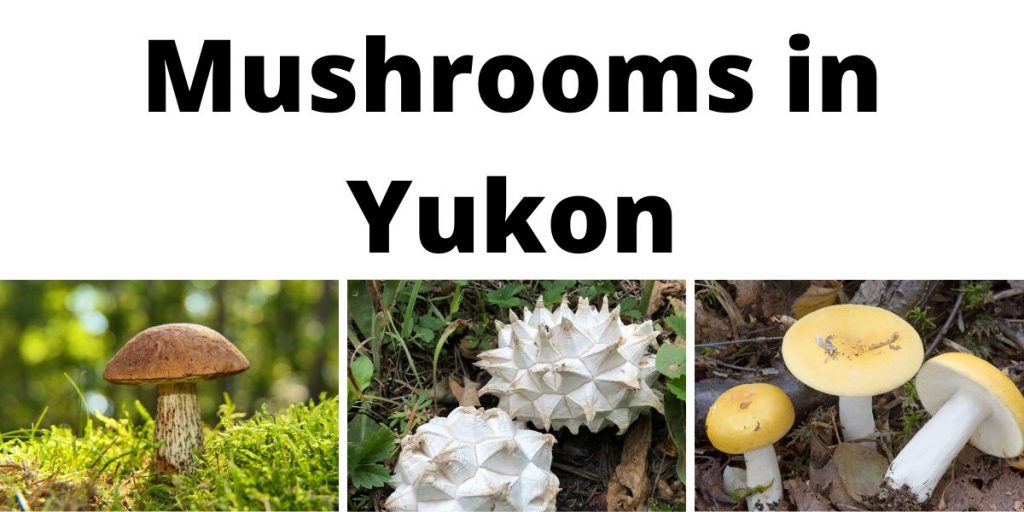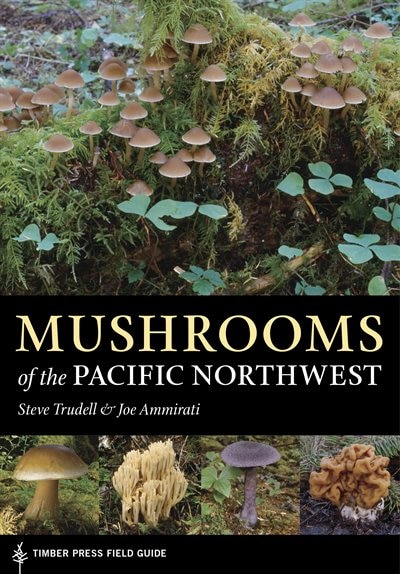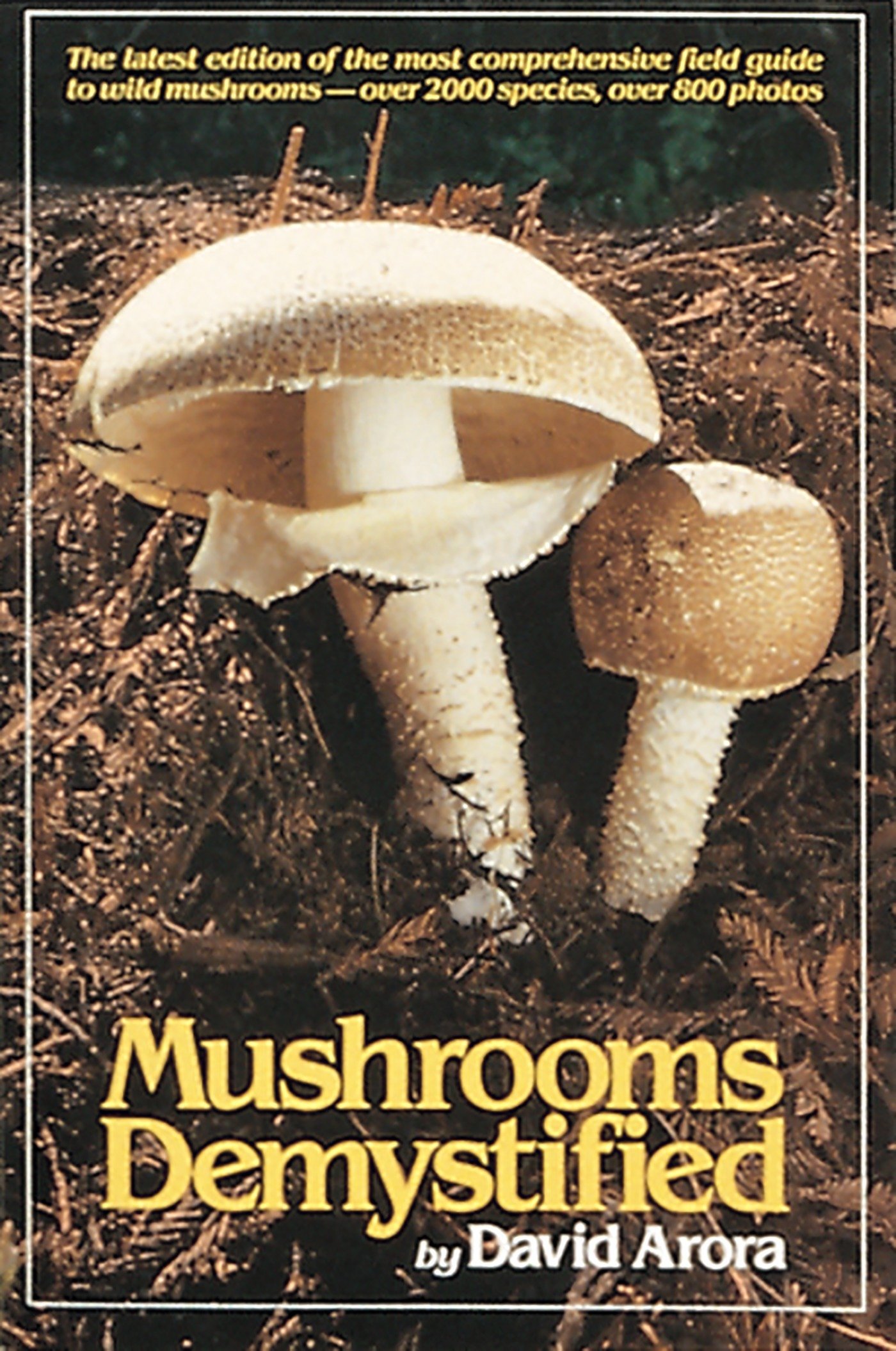The Yukon is small, sparsely populated by humans—and while not as cold on average as other parts of Northern Canada, it does have colder cold-snaps[i]. Most of the territory is naturally forested (as opposed to tundra) however, and does have its fair share of mushrooms[ii].
Astute readers may notice the absence of any “magic” mushroom section in this article. That’s not an oversight on our part, we simply haven’t been able to document the presence of any such species in the Yukon. Possibly, it’s just too cold.
Beginners in the world of all things mushy often ask “what is this and can I eat it?” If you have to ask what it is, you’re not ready to eat it unless you have a more experienced forager along with you. It’s not that identifying mushrooms is really so hard (except with the brittlegills; they really are that hard), it’s that beginners don’t yet have a sense of which details are important and can easily overlook things. Mushroom identification is harder and less reliable for beginners than for people who have gotten used to mushrooms.
This list is intended purely for educational purposes and should not be relied upon as a replacement for a field guide, spore prints, or an identification app. When engaging in mushroom hunting, it is highly advisable to seek in-person expert guidance. Additionally, it is recommended to equip yourself with a top-notch knife and a basket or bag.
That’s why we don’t provide complete identification information here. Our aim isn’t to help beginners forage—it’s to give give future foragers reason to begin.
Our Recommended Field Guides for the Yukon
COVER | TITLE | Header | ||
|---|---|---|---|---|
OUR #1 RATED | ||||
Edible Mushrooms in Yukon
Mushrooms (Agaricus sp.)
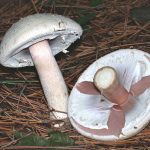

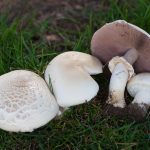

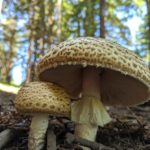

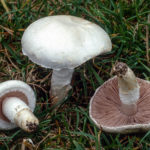

Ever wonder why the species that includes white button mushrooms, criminis, and portabellos seems to have no common name of its own overall? Well, it does have a common name, and its common name is “mushroom”. All other mushrooms borrow the word from this one by a process of extension. But perhaps close relatives of the cultivated mushroom can lay claim to the term in its strict sense, too. If so, then the Yukon has at least four species of true wild mushrooms. Please note that these do have toxic look-alikes, including some of the dangerous Amanitas.
The Wood Mushroom (Agaricus sylvicola) and the Horse Mushroom (Agaricus arvensis) have a distinct anise-like scent that should help distinguish them from poisonous look-alikes—don’t neglect to check for their other identifying characteristics, though[iii]. The Prince (Agaricus augustus)[iv] earns its name by being delicious as well as quite large, though some eaters find it disagrees with them, so it’s best to use caution when trying it for the first time. The prince has a distinctive almond odor. The Meadow Mushroom (Agaricus campestris) may or may not grow in North America—apparently quite a number of specimens, on close examination, have proved to belong to some other, nearly identical species[v]. The general consensus, though, is that if it looks like a meadow mushroom it is edible in moderation[vi].
Boletes
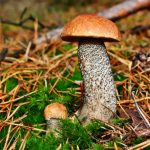

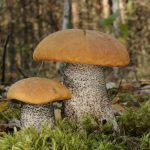

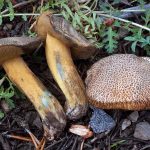

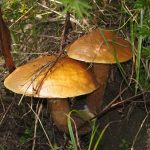

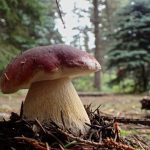

The boletes are a group of mushrooms that all share a classic, umbrella-like shape and the presence of pores rather than gills. They are related, though no longer all classified in the same genus. Although there are some poisonous boletes, most are safe to eat, and some are choice. At least six edible boletes grow in the Yukon.
The Aspen Bolete (Leccinum insigne) is considered good eating, provided it is cooked properly to destroy its toxins, which aren’t dangerous but are unpleasant[vii]. The same precaution probably applies to the Orange Birch Bolete (Leccinum versipelle),[viii] too. The two are similar to each other and are both sometimes called the birch bolete. The Blue-Staining Slippery Jack (Suillus tomentosus)[ix] and the Larch Bolete (Suillus grevillei)[x] are both soft and somewhat slimy in texture, but they are safe to eat in moderation. The Rocky Mountain King (Boletus rubriceps) is one of a group of mushrooms until recently thought to be all the same species—they aren’t, but they are similar-looking and similarly delicious[xi].
Puffballs
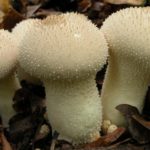

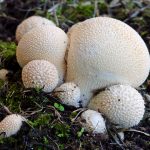



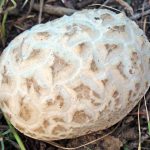

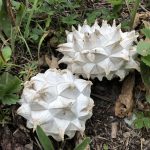

Puffballs are a group defined by the shape of their fruiting bodies—many puffballs aren’t related to each other, they just look vaguely alike. While some people say that all puffballs are edible, and similar-looking toxic species aren’t really puffballs, that amounts to treating edibility as a taxonomic category, which isn’t fair or useful. The Yukon has quite a number of edible puffballs. If you want to eat any of them. Learn how to differentiate them from toxic look-alikes—and make a point of slicing each one in half vertically before eating to make sure that the interior is white and homogeneous. Once the interior starts to discolor—a sign that the spores are maturing—even edible puffballs cease being edible. And any hint of internal structure means that it’s not a puffball but the earliest stage of something else, possibly a deadly Amanita.
Common Puffball (Lycoperdon perlatum) is perhaps the best of the small puffballs, which is fortunate as it grows almost everywhere. It has a short, thick stalk and is covered with tiny bumps, at least when young. The Stump Puffball (Lycoperdon pyriforme) is similar but smooth, plus its skin helpfully darkens once its spores begin to mature. The Meadow Puffball (Lycoperdon pratense) is also smooth, except when very young. Neither stump nor meadow is considered as good as the common puff. Two close relatives of these three also live in the Yukon but should not be eaten, as their edibility is unknown, and one is thought to be possibly mildly poisonous.
Western Giant Puffball (Calvatia booniana) is aptly named, as it can be basketball-sized. It has no stem. Its skin is somewhat more textured than that of its better-known eastern relative, the giant puffball. The Sculpted Puffball (Calvatia sculpta) does have a short, thick stem, plus its surface is covered by large, pyramidal warts. It is large but not huge, perhaps grapefruit-sized. Puffballs are a little difficult to cook properly, as their texture can be a problem and their skins must be peeled away. Also, they have so much protein that they spoil rapidly once harvested, same as meat does and must be refrigerated—a challenge for a mushroom the size of a basketball!
Inkcaps
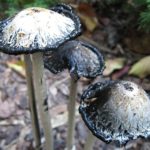

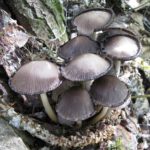

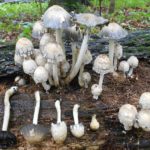

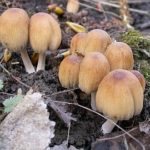

Inkcaps are another superficially similar group that aren’t actually related to each other. What they have in common is they turn to inky goo at maturity. Picking them triggers gooification also, so they have a shelf-life measured in hours. Many writers assert that of course inkcaps are only edible before they begin to turn to ink, but actually the ink is edible also.
Shaggy Mane (Coprinus comatus) may be the best inkcap as far as eating goes. Occasionally, young poisonous nightshades are mistaken for shaggy manes, though—the resemblance is not close, but it’s close enough to happen when people cut corners with their identification practices. Common Inkcap (Coprinopsis atramentaria) is sometimes said to be poisonous. It isn’t, but consuming it makes alcohol poisonous for close to a week. If you are willing to forgo alcohol for a week, eating inkcap is fine. The Scaly Inkcap (Coprinopsis variegata) and the Mica Cap (Coprinellus micaceus) are both uncertain[xii]. The former definitely causes a problem with alcohol and may or may not also have some toxin of its own—reports differ. The latter is generally recognized as edible, but sources differ on whether is causes issues with alcohol.
Brittlegills (Russula sp.)
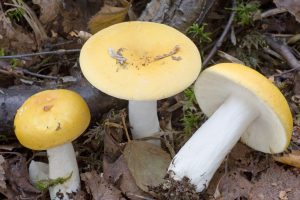



The Brittlegills are pretty mushrooms—most are brightly colored. Some are unpalatable or mildly toxic, but some are good to eat and reportedly delicious. The Yellow Swamp Brittlegill (Russula claroflava)[xiii] has a yellow cap and is white elsewhere. It may in fact be more than one species, as many mushrooms found on multiple continents turn out to be, they do all seem to be edible with a pleasant, mild flavor and a firm texture. The Shrimp Mushroom (Russula xerampelina)[xiv] is definitely a complex of species that may not be well sorted out yet. They are all dark red to purple on top and pinkish to cream elsewhere, with a distinctive, shrimp-like scent. They are popular for the table.
Oyster Mushroom’s
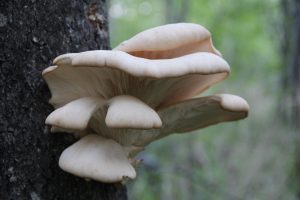

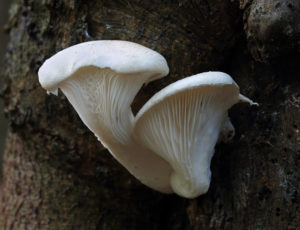

Oysters are a group of mushrooms known for their delicate flavors and textures—they are rarely sold as they don’t transport well. The name does not refer to their flavor but to the appearance of some species in the group. The Yukon has at least two: the Aspen Oyster (Pleurotus populinus) and the Veiled Oyster (Pleurotus dryinus).
Our Recommended Field Guides for the Yukon
COVER | TITLE | Header | ||
|---|---|---|---|---|
OUR #1 RATED | ||||
Poisonous Mushrooms in Yukon
Very few mushrooms are poisonous, and most of those that are cause only mild illness. There are exceptions, though, and there are many mushrooms that are poisonous sometimes under some circumstances for some people. It’s worth knowing something about the mushrooms one should avoid. The following list is by no means exhaustive—please don’t assume a mushroom is safe because it’s not listed here!
Also, please don’t ever use any kind of rule of thumb to determine which mushrooms are safe to eat. All such rules have exceptions, and the exceptions sometimes kill people. The only way to know whether a mushroom is poisonous is to identify it to species and look it up.
Fly Agaric (Amanita muscaria)
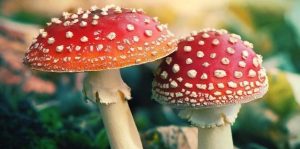

Fly agaric is usually not deadly, and in fact if it is properly processed it can be used as a magic mushroom, though its active ingredient is not psilocybin. But improper processing can lead to a very bad experience, and the mushroom can be dangerous.
This species is also part of a group that includes some of the most toxic mushrooms in the world. Many people recommend avoiding all Amanitas for that reason alone.
Red Russula (Russula sp.)
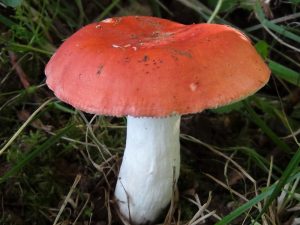

While some Russulas are good to eat, some are unpalatable or even mildly toxic. Unfortunately, Russula taxonomy is still a bit of a mess, making certain species more or less impossible to identify. Perhaps the safest thing is to keep all red-and-white Russulas off the table. There is a reason these mushrooms are referred to as “The Sickener”.
Earthball (Scleroderma citrinum)
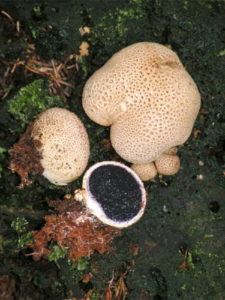

Earthballs are toxic puffballs. Eating them isn’t deadly but is deeply unpleasant. The simplest way to differentiate them from the edible puffballs is a gentle squeeze—edible puffs are soft, like a marshmallow, while earthballs are more like a rubber ball. But if you miss that sign, slicing an Earthball open should reveal your mistake as all but the very youngest specimens are dark inside.
Brown Rollrim (Paxillus involutus)


The Brown Rollrim contains a cumulative toxin, meaning that if you eat a meal of it, you might not get sick. Two meals might be fine. You could eat this mushroom regularly for years without trouble—until you cross a hidden threshold and suddenly get very ill, or perhaps even die of the poison.
Angel’s Wings (Pleurocybella porrigens)
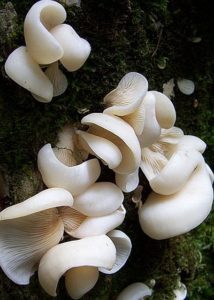

Angel’s Wings is a curious case. The species was considered an edible in good standing until one year it sickened and killed a number of people. Apparently there is a very low, but quite real, risk of serious illness and even death with this species, so that most people who eat it are fine, but then somebody gets unlucky—the year of the fatalities, unusual weather has produced huge flushes of this mushroom in Japan, so a lot more people ate a lot more of it than normally do, and more people got unlucky.
Our Recommended Field Guides for the Yukon
COVER | TITLE | Header | ||
|---|---|---|---|---|
OUR #1 RATED | ||||
References:
[ii] (n.d.). Yukon. iNaturalist
[iii] (n.d.). Agaricus sylvicola (Vittad.) Peck—Wood Mushroom. First Nature
[iv] (n.d.). Agaricus augustus Fr.—The Prince. First Nature
[v] Kuo, M. (2018). Agaricus campestris. MushroomExpert
[vi] (n.d.). Agaricus campestris L.—Field Mushroom. First Nature
[vii] Bergo, A. (2023). Scaber Stalk or Leccinum Mushrooms. Forager Chef
[viii] (n.d.). Leccinum versipelle (FR. & Hök) Snell—Orange Birch Bolete. First Nature
[ix] Wood, M., Stevens, F. (n.d.). California Fungi—Suillus tomentosus. The Fungi of California
[x] (n.d.). Suillus grevillei (Klotzsch) Singer—Larch Bolete. First Nature
[xi] Aon, O. (2021). The Rocky Mountain Red, Boletus rubiceps. Forage Colorado
[xii] Jenny (2022). Inky Cap Mushrooms: Identification and Cooking. Mushroom Appreciation
[xiii] (n.d.). Russula claroflava Grove—Yellow Swamp Brittlegill. First Nature
[xiv] Wood, M., Stevens, F. (n.d.). California Fungi—Russula xerampelina. Fungi of California

